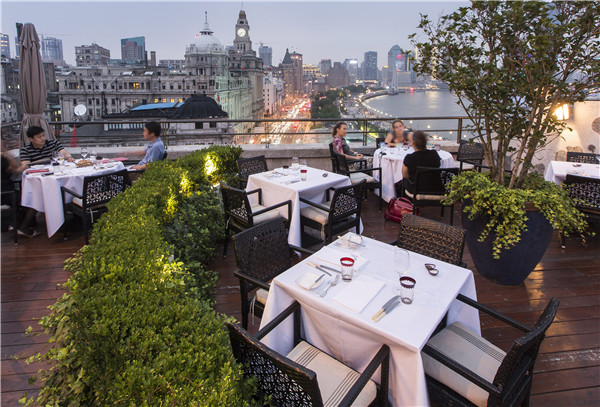 |
|
A view of M on the Bund, the first fine-dining restaurant to appear along Shanghai's most famous tourist stretch. CHINA DAILY |
The Bund, Shanghai's famous riverfront along the western bank of the Huangpu, attracts up to 900,000 visitors every day, but only about 10 percent of them are locals, a fact which will soon become history as a grand project is underway to commercialize the upscale area with commoner-friendly restaurants.
The Bund represents Shanghai's glorious past and its current position as China's financial capital. Evening rush hours often see crowds pouring onto the streets in the area: people heading home after work or to pubs and resturants for happy-hour drinks.
The Bund area is home to banks and trading houses, all located in the old regal buildings that line the streets.
"The weird thing about the Bund is that everyone knows it and likes it, but the locals hardly visit it," said Wang Chih-Jen, an executive in the development and management team at Bund 5, a six-story 1920s building that is gearing up to house restaurants soon.
Bund 5 is among the properties that is expected to see much action in the days to come. Real estate developers, restaurateurs and the city's government officials are looking to turn the waterfront stretch into a prime dining area for not just wealthy tourists but locals, including those driving through the Bund streets.
The Transportation Commission estimates 80 percent of the vehicles that use the six-lane road by the Bund every day merely pass through, and do not head toward any attraction or restaurant in the area.
Bund 5, the headquarters of Nisshin Kisen Kaisha, Japan's largest shipping company in China in 1920s, will be the first to attempt to change the situation.
Some ten restaurants will open in it and offer multiple cuisines. Food will range from South American steak and hot pot to Western fine dining items.
Dozens of restaurants are expected to open in the next few years in the Huangpu district, where the Bund and 100-plus restaurants are located.
So far, factors like traffic congestion, limited parking bays and the notion that the Bund is for only the rich and foreigners, kept local residents from the area. Such notions were not completely unfounded.
The Bund is where Michelin-starred chef Jean-Georges Vongerichten runs his swanky establishments such as Jean-Georges and Mercato. The area is also home to Paul Pairet's Mr and Mrs Bund, a modern French restaurant where customers usually spend at least $100 per person for a meal.
So, the new restaurants will try to rid the Bund of its elitist image by becoming wallet-friendly. "The average cost per person at most of the restaurants in Bund 5 will be around 300 to 500 yuan, which should be affordable for important celebrations or occasions once every few months," said Wang.
That would herald a massive change for Michelle Garnaut, an Australian restaurateur and chef who first opened the M on the Bund in 1999. "When I decided to open a restaurant here, everyone warned me that nobody was ever gonna eat on the Bund. For the first five years, we were all alone in this area, a dark and dingy place that barely had anything else."
For a long time, the M on the Bund was the preferred restaurant of prominent visitors such as the United Kingdom's Prince Edward and media tycoon Rupert Murdoch.
But it was not until 2004 that the century-old area started to gain a buzz. That year, Entrepreneur Vanna Teng turned the former Standard Chartered Bank building into a department store-like property that combined luxury shops, art galleries and fine-dining places.
For years after, plush fashion boutiques and jewelry stores transformed the Bund into the acme of luxury shopping in China. However, with slowdown in the luxury goods industry in recent times, major brands such as Patek Phillipe and Giorgio Armani started to vacate the premises while restaurants gradually began to enter the scene.
If there is one establishment the new restaurants in Bund 5 can emulate, it would probably be The Nest, a lounge bar that became an instant hit with the locals when it opened in December 2014.
It is a product of a collaboration between nightclub brand Muse Group and French vodka brand Grey Goose.
Located slightly away from the central areas of the Bund, the classy place offers a relaxing atmosphere, and has earned itself a reputation for quality cocktails and creative culinary creations that don't come with price tags locals would scoff at.
According to Mark Klingspon, managing director of The Nest, more than 80 percent of the guests are young Chinese professionals, working for international brands and companies. He added The Nest has enjoyed double-digit growth for 11 consecutive months now.
"We are either very lucky or we did something right. I think we have connected to a guest demographic that most restaurants would dream of attracting," said Klingspon.
